Savannah’s Homegrown Green Infrastructure
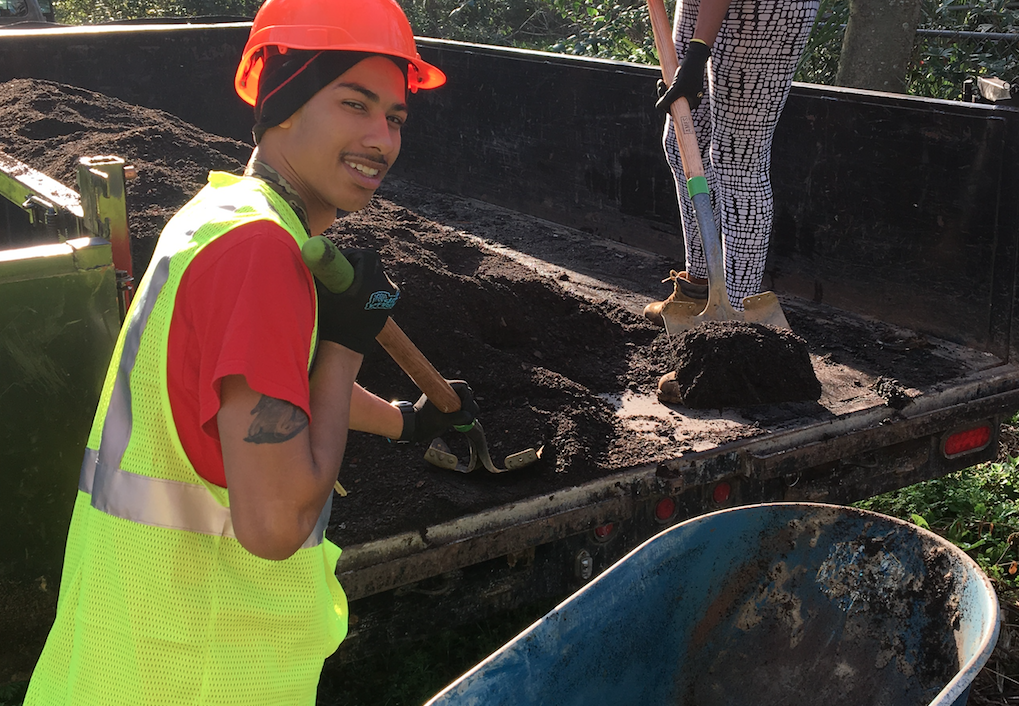
Reviving hope for the city’s marginalized neighborhoods
It’s a drizzly day in Savannah, Georgia, but 16 budding landscape professionals work together to install an irrigation system on what used to be an overgrown, vacant lot in the East Side neighborhood. This group of apprentices has already spent days clearing old growth, underbrush and trash from the site. Now they dig trenches, fit together pipes and hoses, and lay tarp for what will soon be the city’s first urban tree nursery.
“I never saw myself as doing anything in landscaping, gardening, that type of thing, but I thought, why not just expand my horizon and try?’” says apprentice Na’Aisha Banks.
Her fellow apprentice, Vanessa Robinson agrees. “I’ve been in housekeeping since I was 16, so I said ‘Let me get out of this. Let me try landscaping, something different.’ And once I got into it I really enjoyed it.”
“This experience has opened my eyes to the world around me, to see all this life and how it works,” says apprentice Akeem Wilson. “It’s not about just lawnmowers and weed eaters, it’s a lot deeper than that. It’s a full circle. Everybody has some part to play in this ecosystem. There’s so much to do and yet, we don’t even notice it. When you do, it’s so beautiful.”
Read the story from the Savannah Morning News and the Associated Press. Watch videos from local news WTOC and WSAV.
Savannah, Georgia, is known for its trees. They create vaulted green ceilings over downtown thoroughfares and play a starring role in the city’s many historic squares. They also provide a cornerstone of the city’s green infrastructure, playing a key part in managing the water that inundates the area during coastal storms. Periodic flooding and storm water management are especially challenging for the lower-lying sectors of the city, which are often home to lower-income residents. But with several public and private partners, Savannah’s Office of Sustainability is creating a new way to replenish trees and revive hope for some of the city’s marginalized neighborhoods.
In terms of managing storm water, tree root systems and leaf canopies help collect moisture, promote evaporation, and prevent erosion. But as Savannah has grown, its trees have been sacrificed. According to a 2015 study by The Savannah Tree Foundation, from 1996 to 2010, the City of Savannah lost 29% of its total tree canopy. With that loss comes a reduced capacity to capture and filter storm water, resulting in localized flooding in the city’s lower-lying areas.
“Most, if not all, of the work we do at the Office of Sustainability is collaborative with community organizations or other nonprofits.”
— NIck Deffley, City of Savannah, Director of Sustainability
When considering the challenges and potential solutions to Savannah’s eroding green infrastructure, Sustainability Director, Nick Deffley, recognized the opportunity not only to rebuild that infrastructure, but also to rebuild hope in three low-income neighborhoods. With the help of a $233,000 grant from the Southeast Sustainable Communities Fund (a project of the Southeastern Sustainability Directors Network and The Kendeda Fund, with support from the Merck Family Fund), Deffley and partners launched a new initiative that combines job training and landscape certification for low-income job-seekers with the creation of new urban tree nurseries for the city.
Growing Trees and Careers
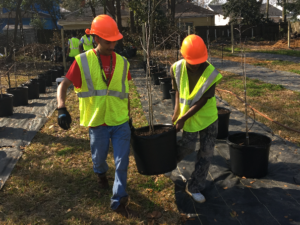
The Savannah initiative provides classroom and hands-on landscape training apprenticeship for participants, with the goal of having each apprentice pass the test to become a Georgia Certified Landscape Professional (GCLP). This certification is held by only 400 or so people throughout the state. As part of their hands-on training, the apprentices are creating three new urban tree nurseries on vacant lots owned by the city. In the process, they learn everything from species identification, landscape design, irrigation system design and construction, pest management, and even how to start and run an independent landscaping business.
A cohort of 19 was initially recruited by WorkSource Coastal, a federally funded workforce development center serving Chatham and other coastal Georgia counties. The group started the five-month program with an intense, four-day training session that included mornings in the classroom and afternoons at the Savannah Botanical Gardens. Deffley shared teaching duties with Jill Gambill, Coastal Resilience Specialist and Public Service Faculty with the University of Georgia (UGA) Marine Extension and Georgia Sea Grant, and Greg Huber, Training Coordinator, UGA Center for Urban Agriculture. UGA provided the curriculum for the apprentices to learn everything required for the GCLP certification.
The apprentices, ranging in age from 18 to 55, continue to meet three mornings a week. Mondays and Fridays, they work on the tree nursery sites, with guidance and direction from Kerry Shay, co-owner of Victory Gardens, a local privately owned landscaping company.
Wednesdays are spent in the WorkSource Coastal computer lab, where members of the cohort take turns leading study sessions to master the GCLP curriculum with support from Deffley.
The apprentices are paid $13.00 an hour for their time, which separates this program from many other job-training efforts.
“The fact that we can pay them is one of the key success factors,” says Deffley. “Most of the workforce programs here do not pay anything.”
But while the lure of paid training may have been responsible for attracting participants to the program, it is a newfound love of plants, landscaping and the environment that keeps them engaged.
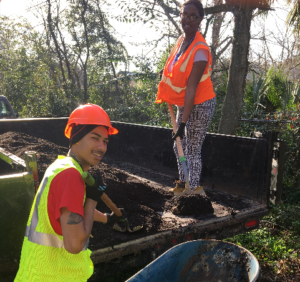
It’s a blessing to be able to help build something in a city that I was born and raised in,” says Antario Quarterman. “I’m learning as I go. And it’s amazing because the way we’re learning is different. First it was studying, but then it was hands on. And as we were doing our studying and hands on we were all communicating with each other. And as we’re going on our day to day lives, we might see some of the trees that we talked about and studied and learned. It’s like, ‘Ooh I know what that is!’”
Make no mistake: the curriculum is daunting, at more than 430 pages of material to master before taking the exam. But the apprentices have tackled it as a team.
In addition to classroom work, the apprentices also learn by doing — clearing years of overgrowth and rubbish from each of the designated tree nursery lots, and preparing them to become tree nurseries. They plant live oaks, which are the signature tree of Savannah, along with magnolias, river birch, tupelo, the salt-tolerant red cedar, and more. In about three years, the City will transplant the trees to other locations throughout Savannah where their storm water mitigation capacity is most needed.
The apprentices range in age from 18 to 55. Some have college credits under their belt. Others are still working toward a GED. Some have criminal records. Some have families to support. Some have worked in menial landscaping jobs before, while others are completely new to the idea. But all are here to succeed and become Georgia Certified Landscape Professionals.
“I like the fact that we’re a team. We’re working together to beautify the environment, and the neighborhoods,” says Na’Aisha Banks. “We have the same goal, so let’s all work together to get it done.
”On Wednesday, it’s classroom time, and Jason Smith volunteers to lead the day’s study session. Together the group works through an online practice test, then reviews their scores.
“How do we all feel about how we did on this?” Jason asks. “Do you guys want to review some more or move on?”
The group is eager and confident. They want to keep moving forward.
The Power of Partnerships
“Most, if not all, of the work we do at the Office of Sustainability is collaborative with community organizations or other nonprofits,” says Deffley. The urban tree nursery is no exception.
Deffley credits the Savannah Tree Foundation with cultivating the initial public awareness of and interest in preserving Savannah’s tree canopy, as well as providing initial guidance on the pilot’s design. They also will work with apprentices on the planting and care of more mature trees.
“As coastal cities are flooding more they’re turning away from some of the gray infrastructure and concrete and learning about the co-benefits for the environment.”
— Jill Gambill, Coastal Resilience Specialist, Georgia Marine Extension and Georgia Sea Grant
WorkSource Coastal took the lead in recruiting the first cohort of apprentices, including several who had just completed the Chatham Apprenticeship Program that teaches “soft skills” required for professional interaction. Worksource Coastal also provides valuable complementary supports that increase each apprentice’s chances of success, including bus passes, help with work attire, hygiene products, resume building, soft skills development and job placement.
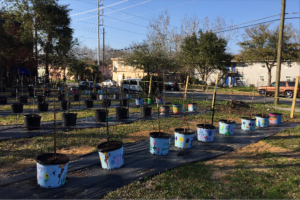
UGA’s Gambill describes the city’s partnership with Georgia Marine Extension and Georgia Sea Grant as a great learning opportunity for her organization.
“I’m the coastal resilience specialist, so through this project, I’m really interested in seeing whether creating urban tree nurseries is a possibility for underutilized lots not only in Savannah, but in every coastal city,” she says. “The apprenticeship is really a green infrastructure training program, and that’s unique. As coastal cities are flooding more, they’re turning away from some of the gray infrastructure and concrete and learning about the co-benefits for the environment. I think there’s going to be more and more job demand for green infrastructure, so hopefully we can set these apprentices up for some good positions.”
Gambill also recognized a shared value of equity among partners in the tree nursery project. “We all care deeply about climate equity and realize that you can’t really be resilient or sustainable if you’re not addressing the socioeconomic challenges,” she says.
For Victory Gardens and Shay, who provides the on-sight supervision and hands-on teaching for the apprentices at the nursery sites, the opportunity to partner in this project means the promise of more skilled workers for the business and industry.
“I’m personally excited about because of the workforce training piece,” he says. “We’ve worked with a couple temp agencies in town, but they provide people with basically no experience or knowledge of the industry. I would rather have somebody who I can invest in — people who are looking for opportunities to advance in the industry. There are a lot of opportunities. I think our system tells people, especially for people who have lacked other opportunities, that if you don’t go to college then you’re not going to have a career path. This is an important piece for connectingthose dots for people who haven’t seen a viable option.”
Even young children are now engaging in the nursery project, thanks to a partnership with Loop It Up Savannah, a popular arts nonprofit that works in multiple area schools. Under the guidance of Executive Director Molly Lieberman, students from eight area elementary schools are painting pots to hold the young trees.
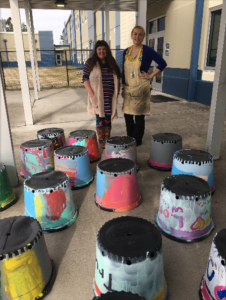
“It’s great to give the kids an opportunity to be part of something that is clearly such a big project, that ties together so many different people and parts of town and different partners,” says Lieberman. “Our focus is helping young people figure out how to be part of the big picture. The kids are learning about the purpose of those pots, the fact those trees are going to be used to help green infrastructure. They’re aware of how we’ve lost a lot of trees between the storms and they know that that’s a problem in a lot of ways, so they’re excited to be able to contribute to the planting of new trees, for sure.”
Fostering Savannah Neighborhood Ownership
While the location and creation of the urban tree nurseries was a city decision, as was the development of the landscape management apprentice program, Deffley and his partners are intentional about engaging residents from the surrounding neighborhoods and inviting them to help shape the overall outcome.
“As we met with the different neighborhoods, we started hearing their concerns,” says Gambill. “They had just gone through two hurricanes where trees fell. And trees, in their mind, were dangerous. And they were concerned about what planting more trees in flood-prone areas might do, and the dangers it might create. We also learned that there was a lot of trust that needed to be built between the City of Savannah in these low-income neighborhoods. I hadn’t appreciated that before. But we are able to take that feedback, change our plans, adapt, and work with them in developing our plans. It has been an eye-opening experience and a model for how these kinds of projects should be run.”
Deffley, Gambill and community engagement consultant Anne Robinson are working with the leaders of resident associations to ask what else neighbors would like to see in terms of beautification or public safety projects. In fact, a portion of the SSCF grant funds are set aside specifically to support these neighborhood projects.
“It’s going to be a neighborhood effort,” says Teresa Young, block captain with the neighborhood association, East Side Concerned Citizens. “Everybody comes together. We express what we want in our neighborhood to beautify our neighborhood. I tell them, ‘This is your neighborhood. If you sit back and you don’t do anything, your neighborhood is going to look the same always.” Deffley envisions the nurseries themselves as neighborhood gathering places. He wants to see residents use the sites for barbeques and parties, or simply as a place to enjoy the sunshine and fresh air. Ultimately, he hopes that residents will feel pride of ownership.
The ultimate piece for me is that community buy into this,” he says. “We’re building a city relationship. This is something tangible. It’s positive that everyone seems to love. And it’s not just happening in this one kind of siloed little spot. There’s going to be a surrounding impact, a ripple effect to that.”
“It’s going to be a neighborhood effort…if we sit back and don’t do anything the neighborhood is going to look the same always.”
— Teresa Young, Savannah’s East Side Concerned Citizens block captain
“A lot of people that pass by, and they see us working on this lot that’s been empty for who knows how long. They come up and ask us questions, and we try to converse with them and let them know what’s going on,” says apprentice Jason Smith.
“What I love about this project is that the same type of thing is going to be happening in multiple neighborhoods, and it’s going to be pulling people from all of those neighborhoods to be involved,” says Lieberman. “That that’s how social change happens.”
An Organic Process
Throughout the pilot, the city and its partners have adopted an organic process that allows for course corrections. One big change involved real estate. The initial plan was to create the urban tree nurseries on “FEMA lots” — residential properties condemned by the Federal Emergency Management Agency (FEMA) as flood prone, unbuildable and not suitable for residential use. FEMA maintains oversight of these properties, and use of them for any purpose requires FEMA approval on a plot-by-plot basis –a process that can take up to a year for each plot.
“There are more than 350 FEMA lots throughout Savannah, many of them in low-income neighborhoods,” says Deffley. “Our thought was to achieve the highest and best use of those properties by creating the tree nurseries on them and then leaving a few trees there for long-term storm water management. But the approval time would have extended beyond our SSCF grant, so we switched to city-owned vacant lots for our pilot. We’re still submitting our FEMA proposal, though, for longer term expansion of this project.”
Spreading Roots for the Future in Savannah
By the end of April 2019, the GCLP apprentices will have planted 550 trees on three city lots, creating new urban nurseries in neighborhoods that had long felt neglected. The benefits to the neighborhoods are readily apparent, but the city also receives an economic benefit.
According to FEMA, every dollar that a city invests in flood mitigation is returned fourfold in benefits. In addition, there will be 16 new trained landscape managers who are more competitive in the area’s job market. And Savannah has created a model that other cities are eager to adopt.
“Other communities in Georgia are hearing about this and saying, ‘We want to do this,’” says Gambill. “That’s not only great because they are thinking about sustainability and green infrastructure, but also because the reason that Savannah was eligible for this grant-funded project is because they have a sustainability director. That’s shining a light on where other communities in Georgia might want to invest their time and attention.”
On a warm day in early spring, community leaders, residents and GCLP apprentices gather for a Green Ribbon Cutting at the city’s first urban tree nursery on Gwinnet Street. City dignitaries make speeches honoring the work, neighbors and visitors wander among 150 young trees in brightly painted pots. The children who decorated those pots wear T-shirts proclaiming “We speak for the trees.” And the apprentices answer questions and talk about their experience with a clear sense of pride. In a few weeks, they’ll gather at City Hall to be honored with a City Council proclamation to recognize their accomplishment. But for now, they soak it all in —the crowd, the trees, and the sunshine —and they think about their futures.
“I know I’m going to pass that [GCLP] test with flying colors,” says apprentice Robert Harwell. “One of my goals is to be a nursery dealer. I want to grow crops, plants, agriculture, and I want to sell it retail. They say money doesn’t grow on trees, but I disagree. It does, and I want to do it.”
The Southeast Sustainable Communities Fund (SSCF) awards grants to local partnerships in the southeastern United States to advance local government policies and programs that will create equitable and sustainable energy and water initiatives. SSCF is a partnership between The Kendeda Fund, The Kresge Foundation, and the Southeast Sustainability Directors Network (SSDN).
For more information please visit www.southeastsdn.org.
Contact: Meg Jamison, meg@southeastsdn.org
All images are used with permission from the City of Savannah.